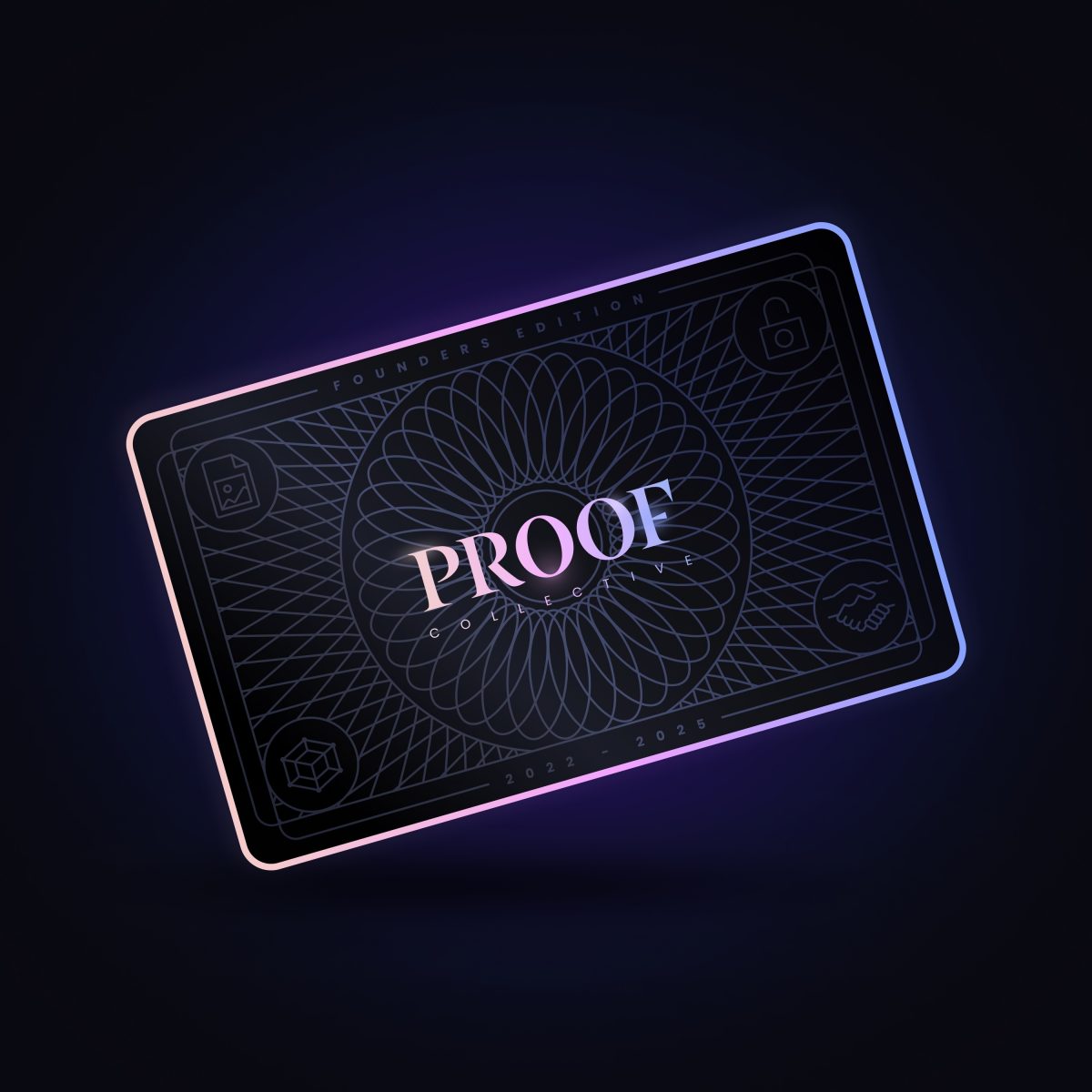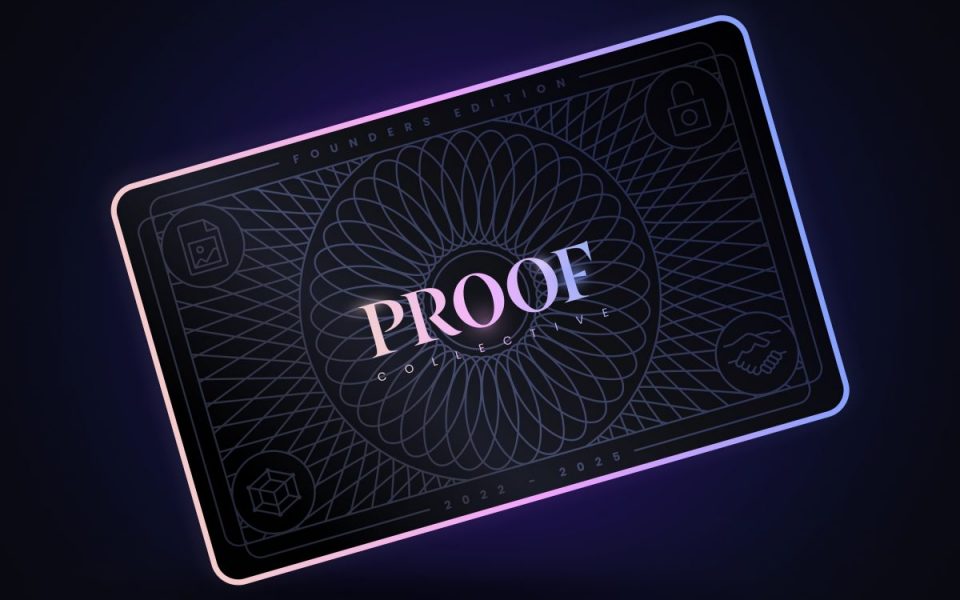A Complete Guide to Proof Collective’s Exclusive Web3 World
We can’t deny it: the concept of identity — and questioning it — is and will remain among the most intriguing capabilities as blockchain technology continues its evolution through modern society’s financial and cultural landscapes.
Keeping in line with the decentralized and open nature of the Web3, anonymity (or pseudonymity) in the crypto and NFT space has forged novel dynamics. Until February 2022, for example, the identities of the founders of Bored Ape Yacht Club, the most successful NFT project in existence, were a mystery.
But anonymity cuts both ways: It allows people to be active in the Web3 ecosystem while retaining their right to privacy, but it also raises some serious issues of transparency and accountability when individuals or groups in the NFT community grow to a scale that commands nearly unrivaled cultural and financial sway.
Proof Collective is one of those groups. And, as a subsidiary of the larger Proof brand that broke out into the NFT scene in early 2022, it’s since become a Web3 powerhouse. But despite its size and influence, it’s less well-known than it should be. So, let’s unpack what this group is all about, where it came from, who its members are, and why that matters for the broader NFT community.
Just what is Proof Collective?
The Proof Collective is an exclusive members-only NFT community responsible for hugely successful projects like Moonbirds, Oddities, Grails, and Emotes. The collective comprises some of the most renowned artists and collectors in the space, though most of them are anonymous.
The collective launched in December 2021 after Co-Founder Kevin Rose turned a subset of the tightly-knit community that had grown up around the PROOF podcast into an organization with a specific mission. That mission? To be the best eyes and ears on the ground in the NFT space, always on the lookout for the next successful project of greatest interest to members.

Okay, how do I join the Elite- …I mean, Proof Collective?
We’re not there yet. To join any group, it’s a good idea to look at its history (and it’s a cornerstone of internet history). Co-Founder Rose was the creative mind behind Digg, the early-2000s social news-aggregation website that, before its ignoble end, helped build many of the core ideas that became hallmarks of Web2 giants like Reddit, Facebook, and Twitter. He’s a veteran of the Web2 world that has successfully translated his keen investing abilities and eye for innovative strategies and talent to Web3.
With the help of co-founder and designer-illustrator Justin Mezzell and the rest of the Proof team, the Collective grew into a Web3 player no one can ignore. On April 16, 2022, Proof launched Moonbirds, the 10,000-PFP project, and the collective’s most familiar project to date.
Moonbirds took the NFT world by storm, becoming one of the top 10 highest-grossing NFT projects of all time less than one week after release. The project’s all-time sales volume has reached an astonishing 166,681 ETH ($284,751,153.16, as of writing).
That project has now grown to include Moonbirds Oddities, a 10,000-piece collection of Moonbird-derived NFTs designed by the successful NFT artist Gremplin, with a sales volume of 15,219 ETH ($25,999,530.84, as of writing).
Okay, now we’ll tell you how to join. To become part of the Proof Collective, you need a Proof Collective NFT, which the group initially released via a Dutch auction starting at 5 ETH per unit. But the group’s price has skyrocketed on the secondary market — for example, owning one will cost you 61 ETH (roughly $104,210), as of writing.
“We want to have curation with a point of view.”
Proof Collective co-founder Kevin rose
That steep floor price comes with an array of benefits, including early access to the PROOF podcast, access to the collectives Discord, free NFT drops, and access to in-person events. But the main draw of the community is the shared knowledge, experience, and prescience its individuals bring to the group.
“We want to have curation with a point of view and really give people the in-depth information they need to make decisions around what to collect and which artists to pay attention to,” said Kevin Rose in an April episode of the nft now podcast. “In the stock world, there are professional organizations that do nothing but gather data and create really in-depth research reports. We want to be that for NFTs.”
In case you missed it, therein lies the principal value of joining the Proof Collective — staying on the inside and knowing high-level intelligence on the NFT ecosystem. The use-value should go without saying, but this is not only great for finding fantastic art and innovative communities. It also means maintaining a better position to invest in projects that pay big dividends.
Another associated name of significant notoriety is the group’s former COO, Ryan Carson, who left the brand less than two weeks after Moonbirds launched, to start his own NFT venture fund. Called 1.21 Gigawatts Fund, Carson’s departure ruffled some feathers in the NFT community, with some coming close to calling it a rug pull. As someone with insider knowledge of the project who was well aware of NFTs with rare traits in the Moonbirds collection, Carson collected more than 200 ETHs in Moonbirds before his sudden departure.
In response to the criticism surrounding Carson’s move, Rose tweeted that he had an internal policy “not to purchase any Moonbirds until rarity counts were out to the public,” but couldn’t stop someone from “clicking a button to purchase.”
Regardless, Rose thanked Carson for his contributions to the project and wished him well in his future endeavor.
Who else is in the Proof Collective?
The Proof Collective website proudly states that its members own more than 150,000 NFTs, including nearly 150 CryptoPunks, more than 800 Bored Apes, nearly 500 Meebits, more than 5,000 Art Blocks, and nearly 330 SuperRare 1:1 NFTs, among others.
That’s one of the most valuable and impressive NFT collections in the entire ecosystem. But it also raises the question, who is bringing these NFTs to Proof’s roster? Most of the collective’s 1,000 members are anonymous. Looking at the blockchain, however, it’s possible to see that some major names in NFTs are or were members — and the connections and relationships those people have to the Proof team raise another question: How much nepotism does it have?
For example, the Proof Collective transferred a membership NFT to Beeple shortly after the NFT pass launched in December 2021. The group also transferred or “sold” membership passes to several other notable and connected figures in the space for next to nothing.
Visual artist Justin Aversano, who goes by the Web3 pseudonym Twin Flames, acquired his pass for 0.001 ETH. Aversano is the co-founder and CEO of Quantum Art, a platform that curates and sells NFTs. In February 2022, Quantum Art raised $7.5 million in a funding round led in part by True Ventures, a venture capital firm whose board includes Kevin Rose. Gary Vee is also a Quantum Art investor and another recipient of a free Proof Collective NFT membership pass (as is his brother). The collective gifted several more passes in this manner to several anonymous wallet addresses.
But the thing is, there’s no Web3 rulebook that says this kind of back-scratching is out-of-bounds, and anyone looking to criticize Proof for doing so should think well on whether or not they would act any differently in the same position. It’s also true that these events don’t help reduce the NFT ecosystem’s reputation for nepotism and big money in-group-out-group dynamics.
Perhaps not everything in Web3 has to align with ideals of equity and a (more) level playing field. Still, such conduct does inhabit a space uncomfortably close to the centralized favoritism of Web2. But to be fair, the Proof brand has recently begun to introduce efforts to make its community more diverse and inclusive, gifting 400 Oddities NFTs to seven communities dedicated to onboarding marginalized populations to Web3. It’s unclear if such gestures and intentions will translate to measurably more inclusivity in the Proof Collective itself, but it’s a good step in the right direction.
The Proof Metaverse: Highrise
Beyond the collective, the Proof brand’s next big goalpost is its metaverse project called Highrise. Rose has been largely light on details when describing Highrise, but he has expressed disappointment overall with other approaches to metaverse projects. “For us, [the metaverse] means a way to connect with community that is different and unique and more immersive than just what’s happening in Discord,” explained Rose on an April 2022 episode of the PROOF podcast.
Highrise, Rose noted, is a placeholder name. Still, it’s one Proof chose purposefully, as it speaks to their vision for the metaverse, namely, in rising above what’s currently on offer to provide users different “buildings” and “floors” of purpose-driven interaction.
“I was really disappointed when I saw the Facebook presentation for their metaverse and they showed two people sitting across from each other in VR playing chess,” Rose continued. “If I had had any Facebook stock, which I didn’t, I would’ve sold it right then and there. Chess? I was doing that on AOL. It showed a lack of imagination, and I kind of just thought, ‘We can do better than this.’”
Given that Proof has done so much in so little time — in a bear market, the brand and the Proof collective will likely continue to be a driving force in the NFT community. Rose and his team have shown a willingness to be flexible when they sense a change in the Web3 winds, like when they announced that they were switching the Moonbirds collection to a CC0 license. That move wasn’t without its own controversy, but few things are in this space. How Proof decides to innovate in Web3 in the future, regardless of its shortcomings, will be anything but mundane.
The post A Complete Guide to Proof Collective’s Exclusive Web3 World appeared first on nft now.


 ) (@kevinrose)
) (@kevinrose)